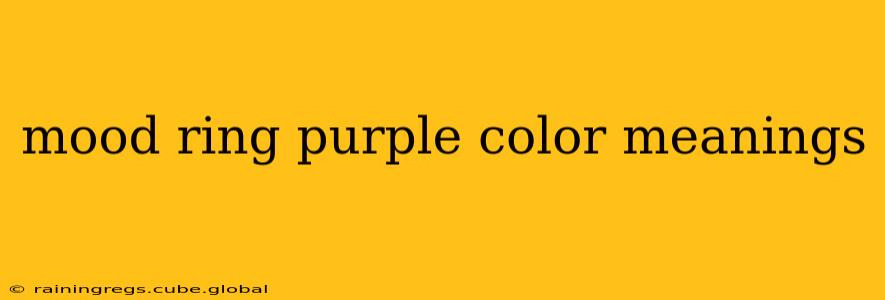Mood rings, those captivating pieces of jewelry that seemingly shift colors with your emotions, have fascinated people for decades. While the science behind their color-changing capabilities is debated, their symbolic meanings remain intriguing. Today, we'll delve into the fascinating world of mood ring colors, focusing specifically on the various shades of purple and what they might signify.
What Does a Purple Mood Ring Mean?
Generally, a purple mood ring signifies a calm and peaceful state of mind. It's often associated with tranquility, balance, and serenity. However, the specific shade of purple can subtly alter the interpretation. A lighter lavender might suggest a gentle, dreamy state, while a deep amethyst could indicate a more profound sense of inner peace and spiritual connection.
Different Shades of Purple and Their Meanings
The beauty of mood rings lies in their nuanced color changes. Let's explore some variations within the purple spectrum:
Light Lavender/Lilac:
A light lavender or lilac hue on your mood ring often suggests a feeling of peacefulness, gentleness, and calm. You might be feeling relaxed, dreamy, and content. This color also represents creativity and imagination, suggesting a playful and imaginative mood.
Medium Purple:
A medium shade of purple, somewhere between lavender and amethyst, generally indicates a balanced emotional state. It represents a sense of harmony, stability, and self-acceptance. You're likely feeling grounded and content, with a sense of inner peace.
Deep Amethyst/Dark Purple:
A deep amethyst or dark purple color on your mood ring often points to a strong sense of spiritual connection, wisdom, and intuition. You might be experiencing a profound sense of inner peace and clarity, feeling connected to something larger than yourself. This can also represent a time of introspection and self-discovery.
Are Mood Rings Accurate?
How Do Mood Rings Work (and Do They Really Work?)
The color changes in a mood ring aren't directly linked to your emotions in a scientifically proven way. Instead, they react to your body temperature. A thermochromic liquid crystal embedded within the ring changes color based on subtle temperature fluctuations. While your emotions can affect your body temperature slightly, the correlation isn't precise enough to make the ring a reliable emotional barometer. Think of it more as a fun, visually appealing way to observe subtle changes in your body temperature rather than a precise emotional gauge.
What Other Factors Affect Mood Ring Color?
Aside from body temperature, several external factors can influence a mood ring's color:
- Exposure to Sunlight: Direct sunlight can heat the ring and cause a color shift.
- Water Temperature: Holding the ring under hot or cold water will dramatically change its color.
- Room Temperature: A warm or cool room will subtly affect the ring's temperature and therefore its color.
Conclusion: The Intrigue of the Purple Mood Ring
While mood rings might not be scientifically accurate emotional indicators, their symbolic interpretations remain a source of fascination. The different shades of purple, from delicate lavender to rich amethyst, offer a captivating visual representation of calm, peace, and spiritual connection. Ultimately, the meaning you ascribe to your mood ring's purple hue is entirely personal and subjective. Enjoy the mystery and beauty of this intriguing piece of jewelry!
